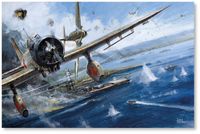
The Sleeping Giant Awakes by Richard Taylor
 |



|
Choose from: Main print Issued with a matching numbered companion print Day of the Rising Sun |
 Richard Taylor’s ‘The Sleeping Giant Awakes’ portrays the scene as the Enterprise slips through the shallow outer channels towards Ford Island and the smoldering ruins that had been the Pacific Fleet. As ships still burn and the stench of destruction hangs in the air, ever alert F4F-3A Wildcats of VF-6 fly an air patrol overhead. Throughout the night the carrier will refuel and re-arm, the fires of the still burning Arizona lighting the night sky. At dawn she will return to sea with a steel resolve and a new mission, to avenge Pearl Harbor.
Richard Taylor’s ‘The Sleeping Giant Awakes’ portrays the scene as the Enterprise slips through the shallow outer channels towards Ford Island and the smoldering ruins that had been the Pacific Fleet. As ships still burn and the stench of destruction hangs in the air, ever alert F4F-3A Wildcats of VF-6 fly an air patrol overhead. Throughout the night the carrier will refuel and re-arm, the fires of the still burning Arizona lighting the night sky. At dawn she will return to sea with a steel resolve and a new mission, to avenge Pearl Harbor.Signatures of THREE veterans who saw action at Pearl Harbor on December 7, 1941. They remember moments from that terrible day:

















